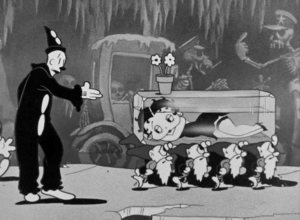Snow-White (1933 film)
Snow-White, also known as Betty Boop in Snow-White, is a film in the Betty Boop series from Max Fleischer's Fleischer Studios[1] directed in 1933.[2] Dave Fleischer was credited as director, although virtually all the animation was done by Roland Crandall. Crandall received the opportunity to make Snow-White on his own as a reward for his several years of devotion to the Fleischer studio, and the resulting film is considered both his masterwork and an important milestone of The Golden Age of American animation. Snow-White took Crandall six months to complete.
| Betty Boop in Snow-White | |
|---|---|
 | |
| Directed by | Dave Fleischer |
| Produced by | Max Fleischer |
| Starring | Mae Questel Cab Calloway (vocal chorus) |
| Animation by | Roland Crandall (as Roland C. Crandall) |
| Color process | Black and white |
Production company | |
| Distributed by | Paramount Pictures |
Release date | March 31, 1933 |
Running time | 7 mins |
| Language | English |
Synopsis
A magic mirror, with a face resembling Cab Calloway, proclaims Betty Boop to be "the fairest in the land", much to the anger of the Queen (who resembles Olive Oyl). The Queen orders her guards Bimbo and Koko to behead Betty. With tears in their eyes, they take Betty into the forest and prepare to execute her. Betty escapes into a frozen river, which encloses her in a coffin of ice. This block slips downhill to the home of the seven dwarfs, who carry the frozen Betty into an enchanted cave. Meanwhile, Koko and Bimbo fall down a hole and arrive at the same cave (with the Queen, who turned herself into a Witch), where the evil Queen turns them into grotesque creatures as Koko sings the St. James Infirmary Blues. With her rivals disposed of, the Queen again asks the magic mirror who the fairest in the land is, but the mirror explodes in a puff of magic smoke that returns Betty and Koko to their normal states and changes the Queen into a hideous and mysterious dragon-like monster. The dragon-like monster chases the protagonists until Bimbo grabs its tongue and yanks it, leaving the dragon-like monster to flee away. Betty, Koko, and Bimbo dance around in a circle of victory as the film ends.[3]
Legacy
Koko's dancing (including some moves that look like a "moonwalk") during the "St. James" number is rotoscoped from footage of Cab Calloway.[4]
The film was deemed "culturally significant" by the United States Library of Congress and selected for preservation in the National Film Registry in 1994. The same year, it was voted #19 of the 50 Greatest Cartoons of all time by members of the animation field.[5] The film is now in the public domain.
See also
References
- Zipes, Jack (2011). The Enchanted Screen: The Unknown History of Fairy-Tale Films. Routledge. p. 120. ISBN 9781135853952.
- Westfahl, Gary (2005). The Greenwood Encyclopedia of Science Fiction and Fantasy. Themes, Works, and Wonders, Volume 3. Greenwood Publishing Group. p. 1238. ISBN 9780313329500.
- Wells, Paul (2013). Understanding Animation. Routledge. pp. 74–75. ISBN 9781136158735.
- rahree (May 10, 2009), Koko the Clown sings "St. James Infirmary Blues" in Betty Boop's Snow White, retrieved May 14, 2018
- Beck, Jerry (1994). The 50 Greatest Cartoons: As Selected by 1,000 Animation Professionals. Turner Publishing. ISBN 978-1878685490.
External links

- Snow White on IMDb
- The short film Snow White is available for free download at the Internet Archive